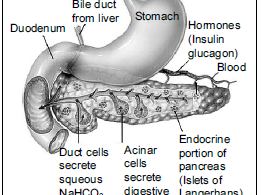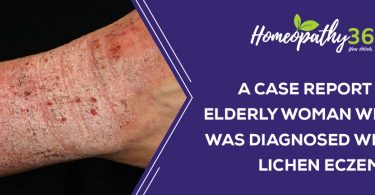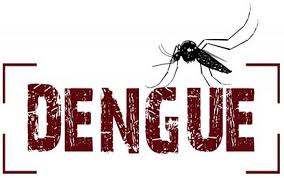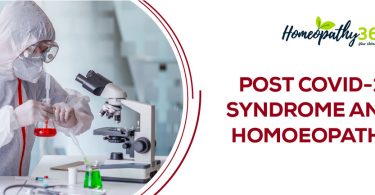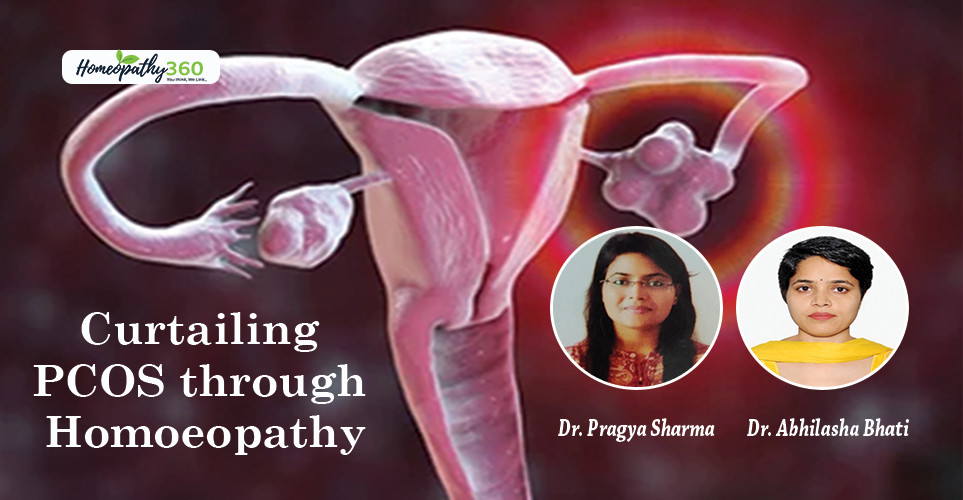
ABSTRACT: Polycystic ovarian syndrome (PCOS) is one of the most common health problems characterized by ovarian dysfunction and hyperandrogenism in reproductive females. Its management is mainly based upon individualization of the patient and totality of symptoms with proper diet and regimen. This article helps to study the background, pathophysiology, clinical features, diagnosis of PCOS along with its homoeopathic management.
Keywords: Polycystic ovarian syndrome, Oligomenorrhoea, irregular menses, homoeopathy, Homoeopathic medicines, hirsutism, hyperandrogenism, hormone imbalance
ABBREVIATIONS: PCOS – Polycystic ovarian syndrome, DHEA-S – dehydroepiandrosterone sulfate, LH – Luteinizing hormone, FSH – Follicle stimulating hormone, DUB – Dysfunctional uterine bleeding, SHBG – Sex hormone binding globulin
INTRODUCTION
Polycystic ovarian syndrome (PCOS) is a complex metabolic, endocrine and psychosocial disorder of reproductive females.(1) The term ‘polycystic’ means ‘many cysts’, and because of the pearl-size cysts in ovaries in small clusters, it was named as PCOS. These cysts are bubbles which are fluid filled (called follicles), containing eggs which are not released yet due to hormonal imbalance. Women with PCOS are also affected with obesity, acne, excessive unwanted hair growth on body, infertility and long-term health related issues that disturbs their quality of life and has a major impact on the psychosocial health of females.(2)
In 1935, this condition was first explained by American gynecologists Irving F. Stein, Sr. and Michael L. Leventhal, from whom its original name of Stein–Leventhal syndrome was taken.(3)
It affects approximately 5% of all women in day-to-day practice. According to the National Institute of Child Health and Human Development (NICHD, USA) and the American National Institute of Health (NIH, USA), the prevalence of PCOS is 4–8% among females of reproductive age. Approx. 18% of women have PCOS according to the Rotterdam criteria.(7) In India, prevalence of PCOS in adolescents is 9.13%.(8)
This article aims to study and understand the Polycystic ovarian syndrome as well as management of this disease along with its important homoeopathic medicines.
CAUSES
PCOS is a multifactorial condition and it’s etiology is unknown but it is believed that heredity plays an important role in causing and maintaining this syndrome. The females exposed to environmental factors like obesity and insulin resistance are more prone to develop PCOS.(9) This disorder is characterized mainly by excessive androgen production by the ovaries.(6)
PATHOPHYIOLOGY(6)
Typically, the ovaries enlarge and increase in volume (> 10 cm3) and stroma.The capsule becomes thick and pearly white in color. There is presence of multiple (> 12) follicular cysts (about 2–9 mm in diameter) crowded around the cortex. Histologically, there is thickening of tunica albuginea and theca cell hypertrophy (stromal hyperthecosis).
Exact pathophysiology of PCOS is not clearly understood but it can be discussed under the following heads:
(a) Hypothalamic-pituitary compartment abnormality leading to increased pulse frequency of LH
(b) Androgen excess due to stimulation of theca cells by high LH, P450C17 enzyme hyperfunction, stimulation of theca cells by IGF-1, etc.
(c) Anovulation.
(d) Obesity and insulin resistance.
CLINICAL FEATURES
- The patient with PCOS presents with obesity, irregular menses with oligomenorrhea, amenorrhea or DUB and infertility. Most of the females also present with hirsutism and acne.
- Specific skin changes can also be seen due to insulin resistance. The skin becomes thick with grey brown pigmentation, called Acanthosis nigricans. Most commonly seen on the nape of the neck, inner thighs, groin and axilla.
- PCOS characterized by hyperandrogenism, insulin resistance and acanthosis nigricans is known as HAIR-AN syndrome.
- Bilateral enlarged cystic ovaries can be observed on internal examination.
DIAGNOSTIC CRITERIA
As per Rotterdam criteria, diagnosis of PCOS is based upon the presence of any two of the following three criteria:(2)
- Oligo/amenorrhoea: absence of menses for 45 days or more and/or ≤8 menses/year.
- Clinical hyperandrogenism: Modified Ferriman and Gallwey Score of 6 or higher.
- Polycystic ovaries: presence of more than 10 cysts, 2–8 mm in diameter, usually with increased ovarian volume of >10 cm3, and an echo-dense stroma in pelvic USG.
As per Androgen Excess Society 2006, PCOS should include Ovarian dysfunction, Oligo/anovulation, Polycystic ovaries on USG, Androgen Excess, Hirsutism and Hyperandrogenaemia.(4)
INVESTIGATIONS(6,14)
- Transvaginal sonography is useful especially in obese patients. Increased volume of ovaries (> 10 cm3). Increased number >12 of peripherally arranged cysts (2–9 mm) are seen.
- Serum values:
- LH level is raised and/or the ratio LH: FSH is > 2:1.
- Elevated level of estradiol and estrone.
- SHBG level has decreased.
- Hyperandrogenism – mainly from the ovary but less from the adrenals. Andro-stenedione is increased.
- Increased serum testosterone (> 150 ng/dl)
- DHEA-S may be raised.
- Insulin Resistance (IR): elevated fasting insulin levels > 25 μIU/ml and fasting glucose/insulin ratio < 4.5 suggests Insulin Resistance.
- Laparoscopy shows Bilateral polycystic ovaries
COMPLICATIONS OF PCOS (6)
- Diabetes mellitus
- Endometrial carcinoma
- Hypertension and cardiovascular disease
- Obstructive sleep apnea.
RUBRICS RELATED TO PCOS
| REPERTORY | RUBRIC | GRADE 1 MEDICINES | GRADE 2 MEDICINES |
| Repertory of Hering’s Guiding Symptoms of our Materia Medica(15) | Genitalia, female, ovaries, affections Genitalia, female, ovaries, swelling (see congested, enlarged, inflammation, tumour)Genitalia, female, ovaries, congestionGenitalia, female, ovaries, tumours | ARN, KREOS, LYC APIS, BUFO, IOD, LACH, LIL-T BELL, SEP APIS, APS, BAR.M, CALC, COLO, LYC, PLAT | Pall, Plat Bell, Con, Ham, Ust Apis, Ham, Polyg-h, Syph, Ust Apoc, Iod, Podo |
| Kent’s Repertory of Homeopathic Materia Medica(16) | Genitalia female; tumors; Ovaries Genitalia female; tumors; Ovaries, cyst | APIS, LACH, LYC | Ars, Bar-m, Calc, Coloc, Iod, Plat, PodoApis, Bov, Bufo, Coloc, Iod, Kali-br, Lach, Plat, Rhus-t |
MANAGEMENT
GENERAL MANAGEMENT
Lifestyle modification is the first line of treatment and it is evident that even 5-10% weight loss has led to significant clinical benefits reducing the sign and symptoms of PCOS.(6)
The conventional medical management of PCOS is symptomatic treatment using metformin, oral contraceptives, anti-androgens, clomiphene citrate and thiazolidinediones for managing different presentations of PCOS along with lifestyle modification with weight reduction.(1)
Aim to reduce weight about 5-10% and manage BMI of < 27 along with dietary changes by limiting carbohydrates and foods high in PUFAandconsuming foods of low glycemic index is advocated.(2) Psychotherapy helps in managing depressive state, Anxiety and stress.(6)
HOMOEOPATHIC MANAGEMENT
In the footnote of aphorism 94 of Organon of medicine, Dr Samuel Hahnemann mentions in detail the points to be noted in case taking of chronic diseases of females.(10) The homeopathic literature, both the materia medica and the repertory are rich in medicines for PCOS and early intervention can assist in preventing further progress and hence deterioration caused by PCOS.
Characteristics indications of some well-known and lesser known homoeopathic medicines for PCOS are:
CALCAREA CARBONICUM: Useful in females who are fair, fat, flabby with a tendency to obesity. Useful in the treatment of polyp of the uterus. Also useful in treating PCOS in women with cutting pains in the uterus during menstruation. It also has good effects in treating early menses as well as long lasting menses with vertigo.(11)
LACHESIS: Patient suffers from pain and swelling in the ovaries more on the left side and cannot bear tightness around the waist. Menses are too short and feeble and pain and other complaints are better by flow.(11)
NATRUM MURIATICUM: Irregular and suppressed periods are the leading symptoms of PCOS. It is an effective remedy for infertility due to PCOS.(11)
THUJA: Patient suffers from severe pain in left ovary and left inguinal region with scanty and retarded menses. There is ovaritis, worse left side during menses.(11)
OOPHORINUM/ OVININUM: Suffering following ovariotomy. One of the main remedies which can be used clinically in cases of infertility and PCOS with the worst form of acne.(13)
PALLADIUM METALLICUM: It is an ovarian remedy which produces symptoms of chronic oophoritis. Pain and swelling in the region of the right ovary. Shooting or burning pains in the pelvis, bearing down; relieved by rubbing. Soreness and shooting pain from navel to the breast. Right ovary affected.(11)
AURUM MURIATICUM NATRONATUM: Induration of ovaries; dropsy of ovary. There is enlargement of ovaries. Asymptomatic ovarian and uterine tumors. Atonic amenorrhoea, scanty and delaying menses, deficient sexual desire, infertility from ovarian torpor.(12)
APIS MELLIFICA: Useful in treatment of Ovarian tumours with congestion of the right ovary which can cause soreness, burning, stinging pain and swelling in the inguinal region. If there is numbness down the thigh this remedy is surely indicated.(11)
OLEUM JECORI ASELLI: Establishes the menstrual flow, and restores it when it is stopped. Abnormal growth of hair on face. Yellow leucorrhoea. There is soreness of both ovaries.(12)
SEPIA: Sepia is an amazing medicine for irregular, too late and scanty menses with bearing down sensation in the pelvic region. The ovaries enlarged with fluid filled cyst in them.(11)
OVA TOSTA: Leucorrhoea profuse and offensive with sensation as if the back were broken into two and tied with a string.(11)
SENECIO: Menses retarded, suppressed. Young girls with functional amenorrhea and backache. Before menses, inflammatory conditions of throat, chest and bladder. After menses commences, these improve.(11) Pain from ovaries to breast.(12)
CONIUM MAC: It is useful in treating acne which is worse before the appearance of the cycle and then disappears after the start of the menstrual cycle. These medicine shows good therapeutic effects in the patients who complains of suppressed, scanty menses with tearing pain in the enlarged ovaries.(11)
FOLLICULINUM: This remedy is used in cases of PCOD, thyroid affections, Endometriosis, Fibroids. There is feeling of being controlled, abused, feeling of being dominated against her will, as if suppressed one’s individuality for someone else, constantly living in self-denial, feeling of emotional drain.(13)
CONCLUSION
There are many more remedies for PCOS in Homoeopathy.We can successfully manage such cases with selection of similar remedy based on totality of symptoms. Proper case taking according to Homoeopathic principles is required for treatment of the patient as a whole. Lifestyle management and counselling also plays a major role in management of PCOS.
REERENCES:
- Central Council for Research in Homoeopathy. Homoeopathy in polycystic ovarian syndrome: A randomized placebo-controlled pilot study. Indian J Res Homoeopathy 2014;8:3-8.
- Rath P. Management of PCOS through Homoeopathy-A case report. Indian J Res Homoeopathy 2018;12:95-100.
- Gupta Y. Polycystic ovarian syndrome (PCOS) – a case study with constitutional homoeopathic treatment. International Journal of Homoeopathic Sciences 2019; 3(1): 22-24.
- Savitha Dr.K., Dynamic Perspectives on Polycystic Ovarian Syndrome.
- Jindal G. A review article on polycystic ovarian syndrome- Homoeopathic Approach [Internet]. Available from: https://www.homeopathy360.com/a-review-article-on-polycystic-ovarian-syndrome-homoeopathic-approach/
- Dutta D.C. Textbook of Gynecology , Enlarged & Revised Reprint of 6th ed. New Delhi: Jaypee brothers medical publishers (P) Ltd; 2013.
- Khmil M, Khmil S, Marushchak M. Hormone Imbalance in Women with Infertility Caused by Polycystic Ovary Syndrome: Is There a Connection with Body Mass Index? Open Access Maced J Med Sci. 2020 June 20; 8(B):731-737.
- Nidhi R, Nagarathna R, Amritanshu R. Prevalence of Polycystic Ovarian Syndrome in Indian Adolescents. Journal of Pediatric and Adolescent Gynecology. 2011 Aug;24(4):223–7.
- Pannakkal J. PCOD – Stein-Leventhal syndrome. 2018. Available from: https://hpathy.com/homeopathy-papers/pcod-stein-leventhal-syndrome/
- Hahnemann’s. Organon of Medicine, translated from 5th edition. With an appendix by R. E. Dudgeon, with additions alterations as per 6th ed. Translated by William Boericke’s and introduction by James Krauss, New Delhi. B Jain Publishers 2000.
- Boericke W. Boericke’s new manual of homoeopathic materiamedica with repertory: Including Indian Drugs, Nosodes, Uncommon Rare Remedies, Mother Tinctures, Relationships, Sides of the Body, Drug Affinities & List of Abbreviations, 3rd Revised and augmented edition based on 9th ed. New Delhi: B. Jain Publishers (P) LTD; 2018.
- Murphy R. Lotus Materia Medica. 3rd Indian edition and 4th impression. New Delhi: BJain Publishers (P) Ltd, 2010-2014.
- Gaikwad G. Materia medica of Sarcodes and Nosodes with therapeutic index. Mumbai, Maharashtra; 2019.
- Thomas R. Theft of Womanhood – Polycystic Ovarian Syndrome: Role of Homeopathy. The Homoeopathic Heritage. 2014; 41-45.
- Kent, J T 1995, Repertory of the Homoeopathic Materia Medica, 4th Indian ed., reprinted from sixth American edition, A.B.Publication, Calcutta.
- Knerr, CB, 2013, Repertory of Herings’s Guiding Symptoms of Materia Medica, B Jain Publishers, New Delhi.
About the Author:
1. Dr. Pragya Sharma – PG Scholar, Bakson Homoeopathic medical College and Hospital, Greater Noida, Uttar Pradesh
2. Dr. Abhilasha Bhati – PG Scholar, Bakson Homoeopathic medical College and Hospital, Greater Noida, Uttar Pradesh


